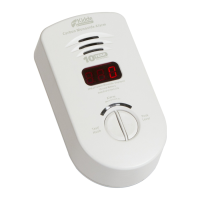
Do you have a question about the Kidde KN-COP-DP-10YL and is the answer not in the manual?
| Type | Carbon Monoxide Alarm |
|---|---|
| Sensor Type | Electrochemical |
| Test Button | Yes |
| Low Battery Indicator | Yes |
| End of Life Signal | Yes |
| Alarm Sound Level | 85 dB at 10 feet |
| Interconnectability | No |
| Alarm Level | 70 ppm |
| Display | Digital |
| Operating Temperature | 40°F (4.4°C) to 100°F (37.8°C) |
| Operating Humidity | 10% to 95% relative humidity |
| Mounting Type | Wall Mount |
| Certifications | UL 2034 |
Details the immediate steps to take when the CO alarm sounds, including evacuation and contacting emergency services.
Explains how the alarm signals CO presence and the function of the Test/Hush button during an alarm.
Provides basic information about Carbon Monoxide (CO) and how the alarm detects it, distinguishing it from smoke alarms.
Specifies that the alarm detects carbon monoxide only and not smoke, fire, or other gases.
Emphasizes that this CO alarm is not a substitute for smoke alarms and does not detect smoke or fire.
States the product is for ordinary indoor residential use, not for vehicles or hazardous locations.
Warns that the device may not fully safeguard individuals with specific medical conditions; consult a practitioner.
Highlights the need for continuous electrical power and notes detection limits below 70 PPM are uninvestigated.
Explains CO is a fatal gas, the importance of the alarm for early warning, and precautions for high-risk individuals.
Details mild, medium, and extreme symptoms of CO poisoning, advising immediate medical consultation for any symptoms.
Defines dangerous, high, mid, and low CO levels (PPM) and recommends actions for each, referencing emergency procedures.
Lists potential sources of CO in homes, including appliances, vehicles in garages, and improper ventilation systems.
Describes various conditions like venting issues, exhaust fans, and temperature inversions that can cause temporary CO levels.
Explains that alarms provide early warning, but their effectiveness depends on placement, installation, and maintenance.
Clarifies the alarm warns of CO but doesn't prevent it. Notes limitations like sensor reach and the need for source determination.
Stresses weekly testing, immediate replacement upon malfunction, and that the alarm won't monitor in an error condition.
Recommends placing an alarm on every level of the home for comprehensive CO detection and avoiding use for other fuel detection.
Identifies key parts of the KN-COP-DP-10YL model, including display, buttons, lights, and plug.
Explains low battery indicators ('Lb', chirping) and the Low Battery HUSH feature to temporarily silence the warning.
Describes the ambient light sensor's role in preventing night chirping and adjusting display brightness based on room light.
Details the 'End' warning (beeps, display) and the End of Unit Life Hush feature for temporary silencing before replacement.
Lists operating temperature, humidity, alarm sound levels, sensor type, power requirements, and alarm response times.
Advises mounting near bedrooms and living areas on each level, ensuring the alarm is audible from sleeping areas.
Lists locations to avoid, such as kitchens, garages, near vents, extreme temperatures, and dead air spaces, to ensure optimal performance.
Provides step-by-step instructions for plugging the alarm into a 120V unswitched outlet, including rotating the plug if needed.
Instructs on applying provided labels with emergency contact information near the alarm and a fresh air source.
Describes the alarm pattern (4 quick beeps, silence) and red LED flashing for dangerous CO levels, and the display behavior.
Explains the initial startup sequence (three 'eights') and the normal standby display ('0') indicating CO monitoring.
Details various digital displays ('CO', 'Lb', 'Err', 'End') and their corresponding sounds, unit status, and recommended actions.
Explains 'PCO' alerts for concentrations over 100 PPM, alternating with the measured level, and conditions for display changes.
Describes how to view the highest CO reading since reset and the procedure to clear the peak CO memory.
Details the process of discharging the unit at end-of-life using the deactivation switch for safe disposal.
Instructs on testing the alarm weekly using the Test/Hush button, describing the expected sound and display sequence.
Provides tips like vacuuming the cover monthly, avoiding cleaning agents/aerosols near the sensor, and not painting the unit.
Lists chemicals and sprays that can damage the sensor or cause false readings, advising relocation during certain activities.
Details FCC compliance for Class B digital devices, addressing potential radio interference and mitigation measures.
Outlines warranty coverage, disclaimers, legal remedies, and performance details for the ten-year period.
Warns that removing the unit's back cover will void the warranty.
Provides information for questions or more information, including a support line number and website address.

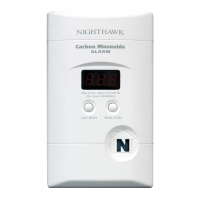
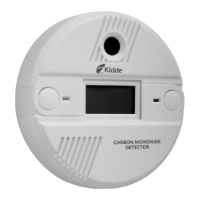
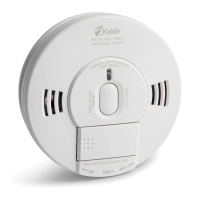

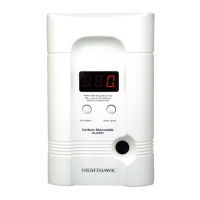

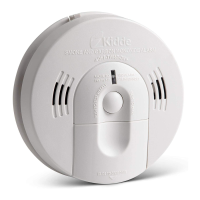
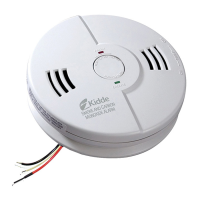
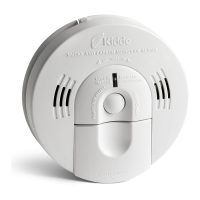
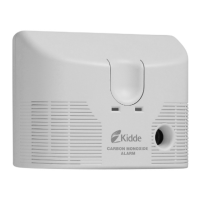
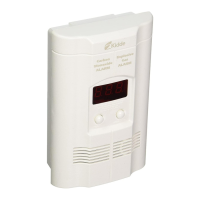
